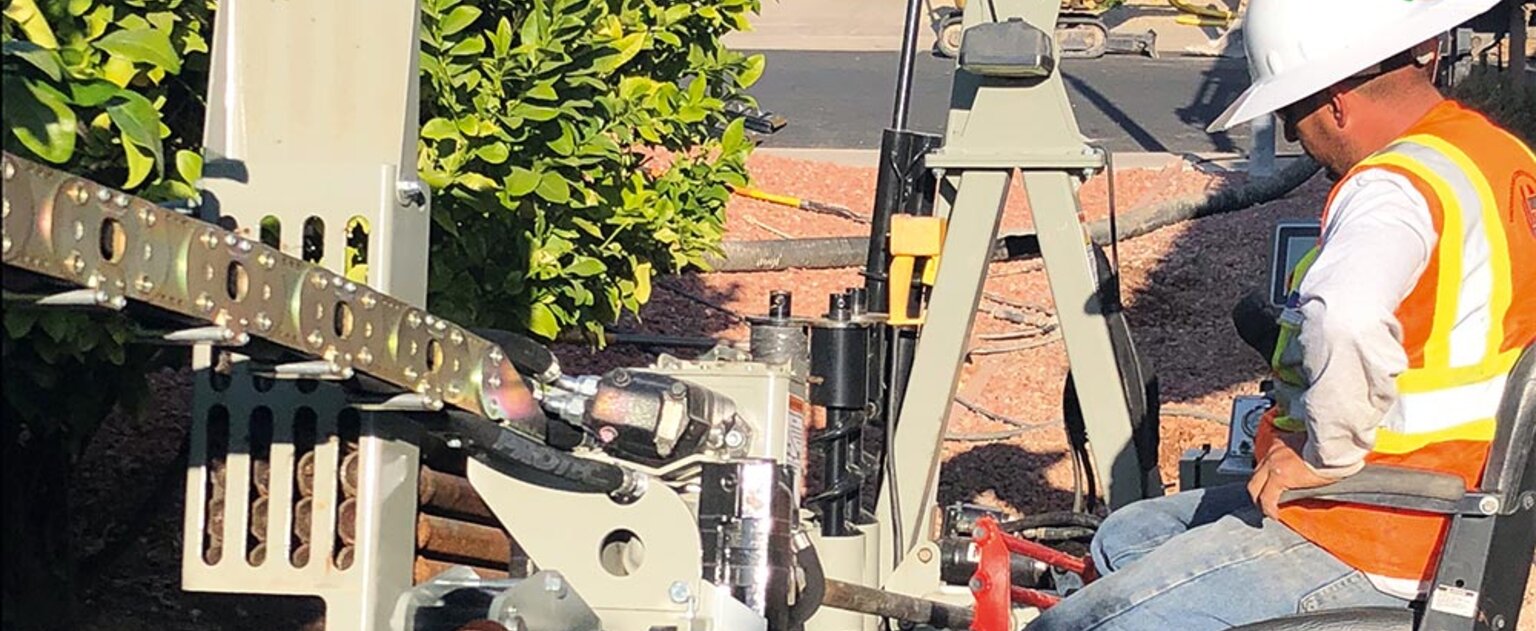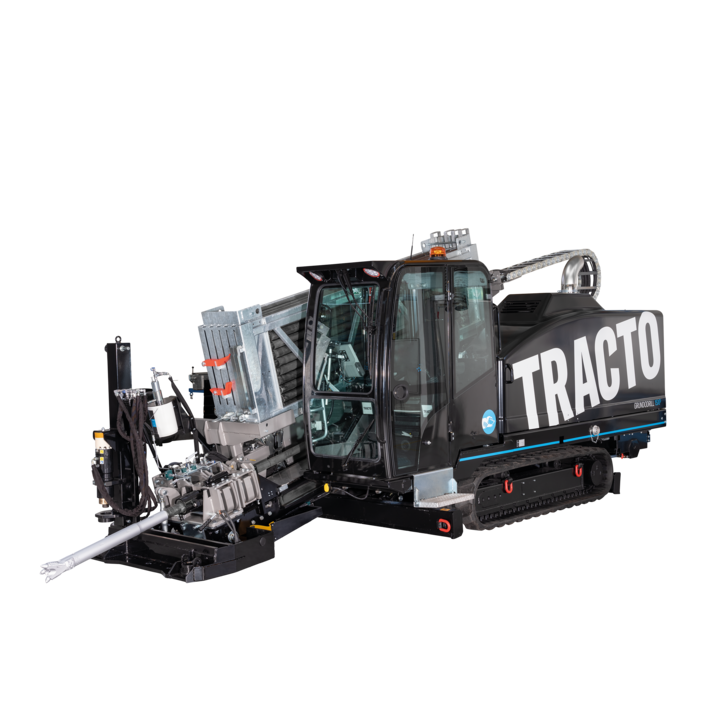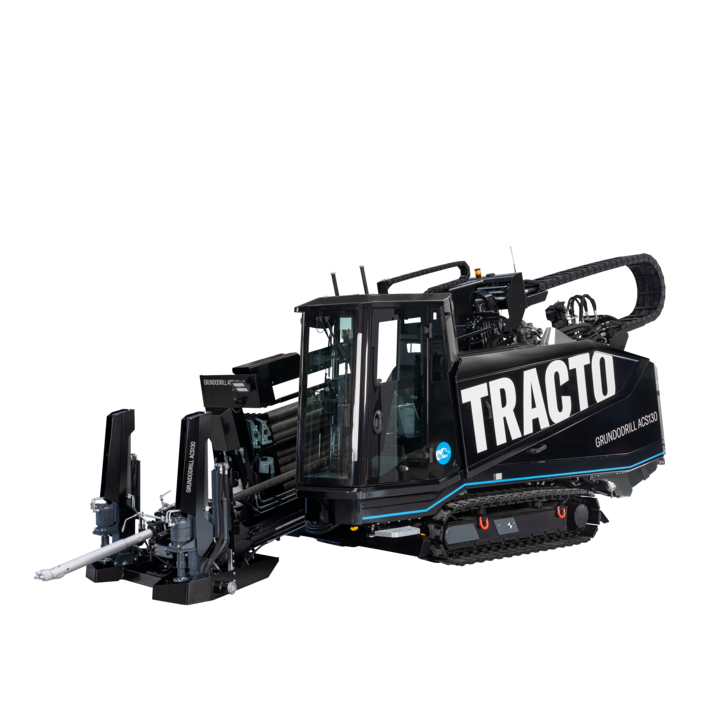
Installation of gas service lines in tough conditions
While it is often assumed that individual methods of trenchless installation tools and technology compete for projects, that’s not always the case.
Underground Construction Superintendent Ernesto Gonzalez explained, “The gas mains and services providing natural gas to the customers were installed in the backyards between the homeowner’s property and the golf course fairways for this development. They were deteriorating and required replacement. New mains were installed in the street and the new gas services needed to be installed from the new mains to the homes. The old system was in the back easements and the new system was being placed in streets in front of the homes. This would also provide easier access.”
Underground Construction crews initially began the project using Grundomat soil displacement hammers provided by TT Technologies in extremely dry, hard and tight ground. In addition, crews had to contend with very narrow workspaces, hardscape, trees and vegetation between homes to reach the home’s gas meter. Open cut was dismissed as too slow and would cause much disruption and difficulties with the restoration of the beautiful and unique landscapes. The GRUNDOMAT was a good choice for this project. Longer runs were proving very time consuming. So Underground Construction reached out for additional more productive solutions.
Versatile and powerful GRUNDOMAT
Soil displacement hammers are some of the most versatile trenchless tools available. The tool can be used in a wide variety of trenchless applications and it is hard to match the productivity and capability of the GRUNOMAT. They can be used as a boring tool, but also be used as a ramming tool and for pipe bursting. Soil displacement hammers are used in water, gas, sewer, electrical, telecom and FTTH applications. In addition, for shorter boring projects, like the ones Underground Construction is using them for, they are very economical on a cost per meter basis.
Installing conduit or HDPE sleeves with the soil displacement hammer can be accomplished in several ways. Often, the soil displacement hammer will pull in some type of poly line or tape during the bore. Once the run is complete, the conduit is pulled in with the poly line. Sometimes after the bore is done, the HDPE sleeve is attached to the front of the soil displacement hammer and installed by backing the tool out through the borehole. Sometimes you can pull it in with the tool’s air hose after the bore. There are many options, and accessories available but in Underground Construction’s case, the gas customer required a sleeving to be installed for the bore. Then, the actual gas carrier pipe was installed by simply sliding it inside of the sleeve.
AZ Project by the Numbers
For the project in Arizona, approximately 3 km of new 76,2 mm mainline sleeving needed to be installed. Once in place, 50,8 mm HDPE gas mains were inserted. In addition, approximately 2,5 km lf of new 38 mm service sleeving also needed to be installed, which equals about 120 home service laterals. Once the conduit was installed, 25,4 mm gas service lines would be inserted. Services from across the street, lengths ranged anywhere from 38 m feet to 15 m depending on the distance from the house or where the meter was located. The ground conditions were rocky and difficult to work in.
The tools allowed for trenchless installation of the gas services avoiding costly open cut restoration and inconvenience to the homeowners. But due to the extremely dry and hard soils, the tools would take 2 - 3 hours to install the new service. The GRUNDOMATs did their job and were very accurate and reliable in these tough conditions. The Underground Construction crews did a great job of using their experience, skills and ingenuity to use multiple tools at the same time from the same launch pits to install more than one service at a time, doubling their production. However, it was decided to bring in a compact directional drill to try and improve productions for the longer service installations, especially in these tough, narrow working conditions.
Compact HDD Pulls Its Weight
Much progress has been made in the function and capability of compact directional drills and they are defined by various criteria. The amount of pullback is also a way to define or categorize directional drills. Ones under 90 kN of pullback are sometimes placed in the compact category; sometimes it’s under 45 kN. The GRUNDODRILL 4X at 4 kN, of pullback and thrust is definitely in the compact category. In addition, they are relatively lightweight and smaller than standard sized drill rigs. They can work in tight, residential area due to their width of around 900 mm.Portability is another factor. Most compact drills can be legally towed behind a 1-ton truck.
For the project in Arizona, it was not only the ability of the compact GRUNDODRILL 4X to deliver the power crews needed to overcome the difficult soils, it was the fact the drill could work effectively in small, confined, residential areas.
For some of the service the GRUNDODRILL 4X was backed up to the house and drilled from the house to the street. But depending on the particular layout they sometimes had to bore from the street to the house. The size of the machine was important. Sometimes they needed to get into the backyards and that access is narrow. The small machine really helped in a situation like that.
The crew was very positive and made it work. Instead of the two to three hours to install new gas services, they were able to install the gas services with the compact drill in about an hour. The crews mostly used the drill for longer runs and continued to use the horizontal boring tools for the shorter runs. The entire project took three and a half months from start to finish. Underground Construction crews completed the final connections with the residences and performed all restoration work as well.
TT Technologies George Mallakis said: “When you face underground conditions that consist of hard, tough soils and tight spaces, there is no substitute for using the appropriate trenchless tools and methods in combination with the best contractors and equipment manufacturers with experienced technical support. Costs and time for completions are reduced between 30 - 50 percent. Not to mention the reduced impact on the homeowners beautiful and personal home landscapes.”

